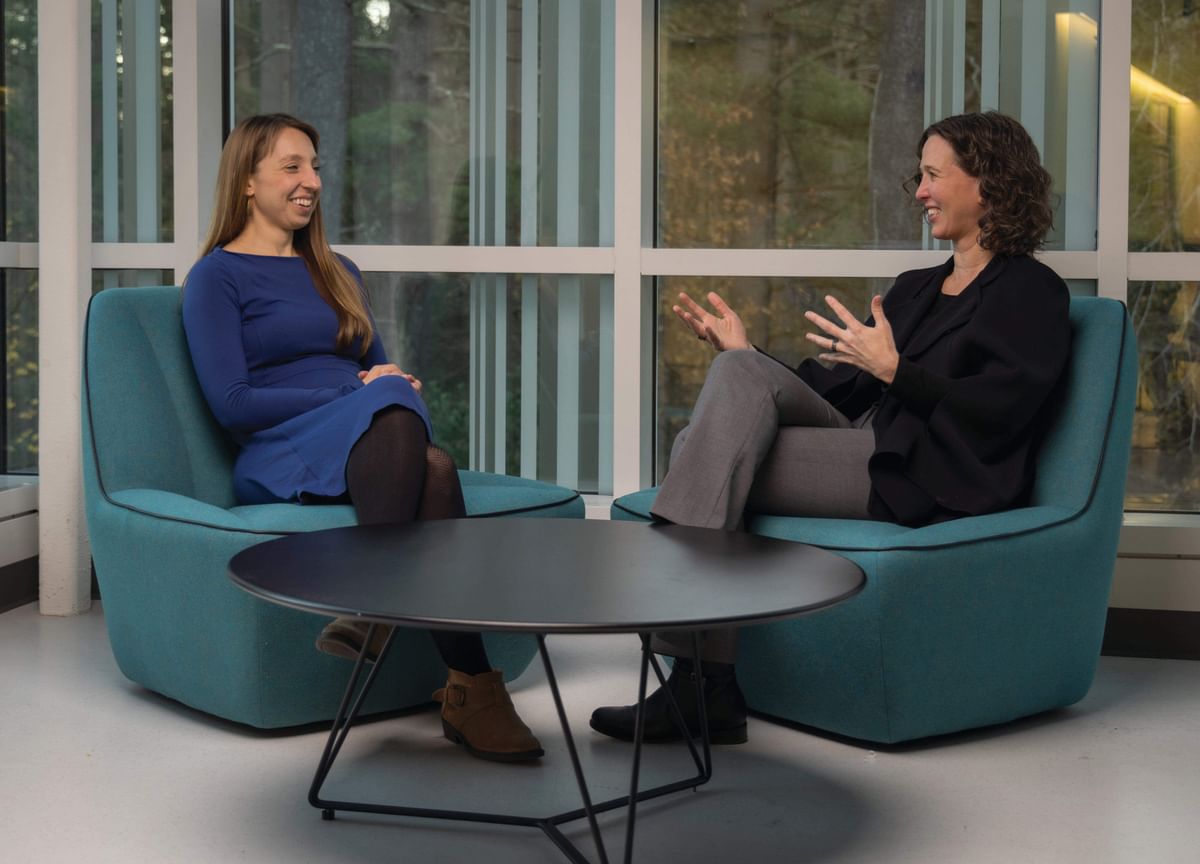- Undergraduate
Bachelor's Degrees
Bachelor of ArtsBachelor of EngineeringDual-Degree ProgramUndergraduate AdmissionsUndergraduate Experience
- Graduate
Graduate Experience
- Research
- Entrepreneurship
- Community
- About
-
Search
All Thayer News

Leading Thoughts: From Climate Science to Climate Policy
Jan 31, 2023 | by Dean Alexis Abramson | Dartmouth Engineer
Dean Alexis Abramson speaks with Professor Erin Mayfield about her work shaping US energy legislation:
Last August, as the US Congress passed the nation's most significant climate change infrastructure legislation to date, I knew I had to talk with Professor Mayfield, whose rapid energy modeling work directly informed the Inflation Reduction Act (IRA). A specialist in energy systems and modeling, she shares how her team shaped important provisions in the almost $370-billion investment in energy security and climate change programs.

Dean Alexis Abramson (right) talks to Professor Erin Mayfield.
Tell us more about your work and its role in the policymaking process for the IRA.
MAYFIELD: I was part of two large modeling studies. One was Net-Zero America, in which we tracked pathways to net-zero emissions. The second, which I co-led, was REPEAT [Rapid Energy Policy Evaluation and Analysis Toolkit], which we set up in advance knowing that legislation was coming down the pipeline. In real time, we modeled legislation and briefed people on the Hill about our findings, including potential impact on air pollution, labor, and affordability. We also helped do some analysis of specific provisions and how those can be better designed.
Walk us through one of those provisions. What was considered? What were the variables?
MAYFIELD: It's not just about driving down costs, it's also about having a labor force to actually build out the infrastructure we need to help reduce emissions. With respect to labor, we helped look at different tax credit "adders" you could tack onto existing credits to ensure fair wages and help retain a workforce that looks like the population where infrastructure is built.
From the perspective of an engineer and scientist, how big a deal is this legislation?
MAYFIELD: It's momentous. To contextualize, there was no way we were going to meet our emissions targets before, and now, this brings us closer. Our modeling shows a 40-percent emission reduction by 2035. That doesn't get us to 50 percent, but it gets us close. And that's just through public investment. It doesn't include private investment motivated by the IRA and the additional impact from private industry goals because of the federal legislation. I'm also passionate about the equity and justice provisions. In the past, equity was an ancillary factor in how US environmental policy was designed. In this legislation, there's specific justice and equity objectives, not just outcomes—and that's unprecedented.
That connection between climate policy and equity seems relatively novel. What has been the catalyst for us to think about legislation differently?
MAYFIELD: There are a few things in play. One is society's broader consciousness of inequities that I feel has been growing through the past couple of years. There's also the political layer. The deciding vote on the legislation was a senator in a coal state, right? So, there was a political side to adding provisions that benefit people who live in coal communities. The passage of the IRA, that's a huge bright spot. From my perspective, you have to get up every day and try to work toward a solution and be tenacious and don't give up. Because that's not an option.
When you think about the future, what gives you and your students a lot of hope?
MAYFIELD: I think students get excited about my work because it's focused how you can problem-solve to find solutions. It makes climate change less an intangible thing that we can't do anything about and more something where we can iterate to make small changes in all these places and contribute, in aggregate, to solve the whole problem. Students are both optimistic and concerned—they know that climate change is a huge problem, that it's going to affect the world and disproportionately impact developing countries and disadvantaged areas. I'm inspired by our students and their enthusiasm for not just finding but also being part of the solution.
For contacts and other media information visit our Media Resources page.
